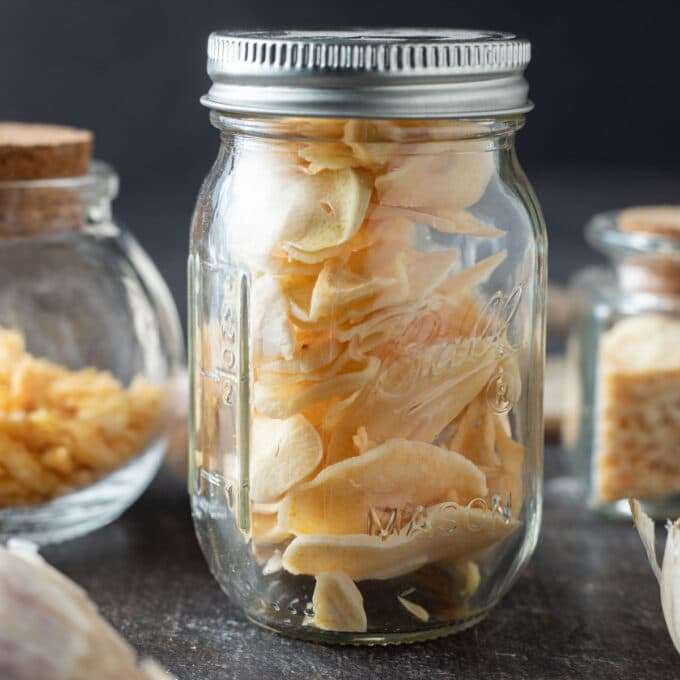
0.0 from 0 votes
Dehydrating Garlic | Garlic Powder
Dehydrating garlic is an easy way to preserve this versatile, early summer vegetable. Make garlic powder too. It's great to add to so many dishes.
Prep Time
5 mins
Cook Time
5 hrs
Total Time
5 hrs 5 mins
Servings: 1 cup
Calories: 276 kcal
Course:
Condiments
Cuisine:
American
Ingredients
- 3 bulbs garlic
Instructions
- Separate cloves from the bulb base. Use a sharp knife to remove the root end of each clove.
Cup of Yum
For dried garlic slices
- Slice the cloves thin into ⅛ inch thick slices. You can cut them lengthwise or width wise.
For dried minced garlic
- Add pieces to food processor. Process until you have small minces.
- Pulse until garlic is fairly fine but not enough to turn it into a paste.
Using your commercial dehydrator
- Lay processed garlic on parchment lined dehydrator trays in a single layer. Place the trays in the dehydrator.
- Set heat to 100-110°F / 40°- 50°C, if your dehydrator has a temperature control.
- Dry for 5-7 hours until they are dry enough to snap between you fingers. The most important thing is get all of the moisture out so that they don’t mold.
Using your oven
- Lay processed garlic on parchment lined baking sheets in a single layer. Place the sheets in the oven.
- Set heat to 100-110°F / 40°- 50°C, if your dehydrator has a temperature control.
- Dry for 2-6 hours until they are dry enough to snap between you fingers. The most important thing is get all of the moisture out so that they don’t mold.
- Allow the dried garlic to cool to room temperature. Then condition it. (Instructions in notes below).
How to make garlic powder
- Once the garlic is dried and conditioned, grind the it with a food processor, blender, spice mill or coffee grinder. You can even use a mortar and pestle. This can take several minutes.
- Sift the powder through a fine mesh strainer to ensure uniform pieces.
- You can either use the large chunks of powder as granulated garlic or place them back in your food processor and continue to grind the pieces until they are finer.
Notes
- Conditioning your fruit is an important step in the drying process, so don’t skip this step.
- Conditioning is the process of testing the fruit to make sure that it is thoroughly dry.
- Even a bit of moisture in a couple of pieces has the potential to ruin a whole batch.
- Allow the dehydrated fruits to come to room temperature. Immediately place them into a glass mason jar. Place the jar in a dark area.
- Shake the jar daily to break up any stuck pieces. Allow them to stay in the jar for 7-10 days, shaking daily.
- If you see any moisture droplets collecting on the jar. You know you have moisture in them.
- If you see any evidence of moisture or any condensation in the jar, re-dry the food in your oven or dehydrator. After re-drying condition them again. Once they are fully dry, pack in tight fitting glass jars.
- If you see any evidence of mold during the conditioning process. Discard the product.
Nutrition Information
Serving
1cup
Calories
276kcal
(14%)
Carbohydrates
61g
(20%)
Protein
12g
(24%)
Fat
1g
(2%)
Sodium
31mg
(1%)
Fiber
4g
(16%)
Sugar
1g
(2%)
Vitamin C
58mg
(64%)
Calcium
340mg
(34%)
Iron
3mg
(17%)
Nutrition Facts
Serving: 1cup
Amount Per Serving
Calories 276
% Daily Value*
| Serving | 1cup | |
| Calories | 276kcal | 14% |
| Carbohydrates | 61g | 20% |
| Protein | 12g | 24% |
| Fat | 1g | 2% |
| Sodium | 31mg | 1% |
| Fiber | 4g | 16% |
| Sugar | 1g | 2% |
| Vitamin C | 58mg | 64% |
| Calcium | 340mg | 34% |
| Iron | 3mg | 17% |
* Percent Daily Values are based on a 2,000 calorie diet.